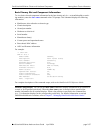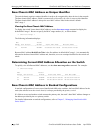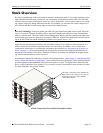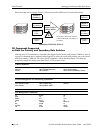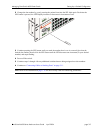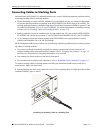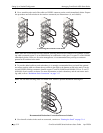
Managing OmniSwitch 6600 Series Stacks Stack Overview
OmniSwitch 6600 Series Hardware Users Guide April 2004 page 3-5
CMM Roles in a Stack
When OmniSwitch 6600 series switches operate in a stack, one switch in the stack will always have a
primary CMM (Chassis Management Module) software role within the stack. This switch will be responsi-
ble for functions such as software and configuration management, web-based management (i.e.,
WebView), SNMP management, switch diagnostics, and software rollback.
Another switch will have a secondary CMM role. This switch acts as a backup, which is always ready to
assume the primary CMM role in the stack if the switch with the primary CMM role fails or goes offline.
Any additional switches will have an idle CMM role in the stack. These switches operate similarly to
Network Interfaces (NIs) in a chassis-based switch.
By default, the primary—or management—role will be given to the switch with the lowest chassis MAC
address. All other switches in the stack will be in non-operational status until slot numbers are assigned by
the user and the stack is manually rebooted.
Once unique slot numbers are assigned to switches in a stack, the switch with the lowest slot number will
assume the primary CMM role while the switch with the next lowest slot number will assume the second-
ary CMM role when the stack firsts boots up. Any other switches in the stack will assume an idle CMM
role. For example, in a stack with switches numbered 2, 5, 7, and 8, Switch 2 will assume the primary role,
Switch 5 will assume the secondary role while switches 7 and 8 will assume idle roles.
In a stack, if the switch with the primary CMM role fails or goes offline for any reason, all the other
switches in the stack are instantly notified. The switch with the secondary CMM role automatically
assumes the primary role. In a stack consisting of two switches, the switch that had the primary role will
assume the secondary role if it comes back online. In a stack consisting of three or more switches the
switch with the next lowest slot number will be assigned the secondary CMM role while the switch that
was originally primary will have an idle CMM role if it comes back online.
Note. If a primary switch goes down in a stack consisting of three or more switches and then comes back
online again, it will assume an idle CMM role, not the secondary role. If you want a switch with an idle
role and the lowest slot number in a stack to regain the primary CMM role you must reboot all the
switches in the stack. (See “Resetting All Switches in a Stack” on page 3-18 for more information.)
CMM Role Redundancy
CMM role redundancy is one of the stack’s most important failover features. The switch with the primary
CMM role manages the current switch operations, the switch with the secondary CMM role provides
backup (also referred to as “failover”), and any remaining switches in the stack are in an idle CMM role.
For CMM redundancy, the software on all the switches in the stack must be synchronized. (Refer to
“Synchronizing Switches in a Stack” on page 3-17 for more information.)
The figure on the following page illustrates the CMM failover sequence:
1 Switch 1 is operating in the primary CMM mode. Switch 2 is operating in the secondary mode—i.e., it
is functioning with the standby CMM role and is ready to take over chassis management functions in the
event of a failure of the switch with the primary CMM role.
2 Switch 1 fails or is taken offline (e.g., the switch is physically removed from the stack).
3 Switch 2 automatically assumes the primary CMM role.
4 Switch 3 automatically assumes the secondary CMM role.
5 Switch 4 remains in the Idle CMM role.



